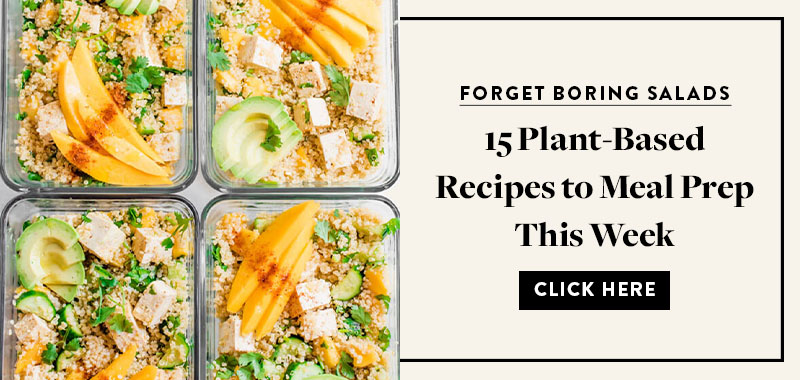If you’re anything like me, some days are a vegetable paradise—healthy and colorful meals all.day.long—while on others, there’s nary a vegetable in sight. So, basically, I’m always striving to fit more vegetables in where I can. And, luckily, it’s pretty easy to sneak extra vegetables into just about anything.
Don’t be surprised when these become your new uniform. Use code TEG15 for $15 off!
Eating plenty of vegetables is super important when it comes to your overall health and well-being. From nutrient deficiencies to higher rates of chronic disease and beyond, focusing on getting enough vegetables in your diet is key. Here are just a few ways that you can up your vegetable intake—without changing things up too much or sacrificing flavor.
1. Add extra to soups, sauces, and smoothies
Soups and sauces probably aren’t too shocking in terms of where you can make sure to get your veggies in, but you can pack a serious punch in both of them. Soups, in particular, are such an easy place to add extra vegetables. There are probably already vegetables in your soup anyway—just add some more. Sauces, too, can be easy spots. Add spinach, kale, broccoli, or even beets to pesto, purée carrots or red bell peppers and add them to a pasta sauce, or make a creamy sauce a little healthier by including cauliflower—the possibilities are endless.
Smoothies are one of my all-time favorite ways to “trick” myself into eating extra vegetables, though. Of course, adding greens to a smoothie is always a good way to go, but there are plenty of other vegetables that make great additions as well. Frozen cauliflower, zucchini, cucumber, and pumpkin or butternut squash purée are all good options. You won’t even taste it.
2. Stick them on a pizza
What’s better than pizza for dinner, you ask? Not much in my book. I don’t guilt myself for eating plain old cheese, but I’ve found that adding herbs and vegetables can make it even better. Try kale, mushrooms, spinach, garlic, potato, peppers, tomatoes, artichoke hearts, a pickled vegetable like giardiniera, carrots, broccoli, and more.
3. Get creative with dessert
Add beets to your brownies, make carrot, zucchini, butternut squash, or pumpkin cakes. It’s such an easy way to get a few more vegetables in your diet. Of course, you’re still eating dessert, so don’t feel too much like the epitome of health, but it’s something!
4. Add them to breakfast
If given the choice, I will always opt for a savory breakfast over a sweet one. The good news? A savory breakfast makes it even easier to add vegetables. Serve your fried eggs over sautéed leafy greens, add tomatoes or mushrooms, make a veggie-packed frittata, quiche, or omelet. You’re already well on your way to your vegetable goal for the day and you’ve only eaten breakfast.
5. Make vegetable tacos, sandwiches, or quesadillas
If you’re a meal-prepper (or even a sort of meal-prepper), roast or sauté a big batch of vegetables at the beginning of the week and then season for tacos, layer onto sandwiches, tuck into quesadillas—it’s just as quick (if not quicker!) than making the veggie-less versions and oh so delicious.
6. Go meatless one day (or more!) a week
Whether it’s Monday or another day, opting to try to go meatless at least one day per week can help you boost your vegetable intake. A meatless day isn’t a guarantee that you’ll eat more vegetables, but you might find that it encourages you to branch out a bit more and get more creative with what you’re eating those days, leaning more on vegetables than you otherwise would.
7. Try a new-to-you recipe
If you don’t usually eat a ton of vegetables, trying new-to-you recipes just might encourage you to eat more. Rather than sticking with your typical side salad, try vegetable-packed meatballs, a vegetarian curry, one-pan dinners, and more. You’ll be introduced to a new dish, but maybe also new foods and cooking techniques. It’s a great way to help shake off your routine.
What to Make
1. Butternut Squash and Apple Hash with Sausage

Source: The Real Food Dietitians
2. Black Bean Beet Burgers

Source: Sweet Potato Soul
3. Spinach Turkey Meatballs

Source: Eating Bird Food
4. Vegetarian Bolognese

Source: Midwest Foodie
5. Zucchini Enchiladas

Source: By Erin Clarke of Well Plated
6. Grilled Green Beans

Source: What’s Gaby Cooking
7. Vegetable Korma Curry

Source: My Food Story
8. Veggie Pizza

Source: Orchids + Sweet Tea
9. Sautéed Greens

Source: What’s Gaby Cooking
10. Portobello Mushroom Fajita Tacos

Source: My Food Story
11. Nut-Free West African Peanut Stew

Source: Sweet Potato Soul
12. Slow-Cooker Ratatouille

Source: Eating Bird Food
13. Mediterranean Flatbread Pizza

Source: Midwest Foodie
14. One-Pan Balsamic Chicken Veggie Bake

Source: The Real Food Dietitians
15. Zucchini Carrot Muffins

Source: By Erin Clarke of Well Plated
16. Mini Sweet Potato Bundt Cakes and Cream Cheese Frosting

Source: Orchids + Sweet Tea


 "
"
